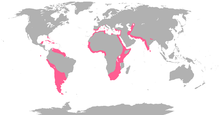Flamingos
| Flamingos Temporal range: 25–0 Ma Late Oligocene – Recent |
|
|---|---|
 |
|
| James's flamingos (P. jamesi) | |
| Scientific classification | |
| Kingdom: | Animalia |
| Phylum: | Chordata |
| Class: | Aves |
| Order: | Phoenicopteriformes |
| Family: |
Phoenicopteridae Bonaparte 1831 |
| Species | |
|
See text |
|
 |
|
| Global distribution of flamingos | |
See text
Flamingos or flamingoes/fləˈmɪŋɡoʊz/ are a type of wading bird in the family Phoenicopteridae, the only family in the order Phoenicopteriformes. There are four flamingo species in the Americas and two species in the Old World.
Flamingo comes from Portuguese or Spanish flamengo, "flame-colored", in turn coming from Provençal flamenc from flama "flame" and Germanic-like suffix , with a possible influence of words like Fleming. A similar etymology has the Latinate Greek term Phoenicopterus (from Greek: φοινικόπτερος phoinikopteros), literally "blood red-feathered".]
Traditionally, the long-legged Ciconiiformes, probably a paraphyletic assemblage, have been considered the flamingos' closest relatives and the family was included in the order. Usually the ibises and spoonbills of the Threskiornithidae were considered their closest relatives within this order. Earlier genetic studies, such as those of Charles Sibley and colleagues, also supported this relationship. Relationships to the waterfowl were considered as well, especially as flamingos are parasitized by feather lice of the genus Anaticola, which are otherwise exclusively found on ducks and geese. The peculiar presbyornithids were used to argue for a close relationship between flamingos, waterfowl, and waders. A 2002 paper concluded they are waterfowl, but a 2014 comprehensive study of bird orders found that flamingos and grebes are not waterfowl, but rather are part of Columbea along with doves, sandgrouse, and mesites.
...
Wikipedia
